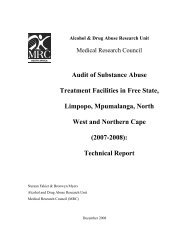Access to substance abuse treatment in the Cape Town metropole ...
Access to substance abuse treatment in the Cape Town metropole ...
Access to substance abuse treatment in the Cape Town metropole ...
You also want an ePaper? Increase the reach of your titles
YUMPU automatically turns print PDFs into web optimized ePapers that Google loves.
adequate fit <strong>to</strong> <strong>the</strong> data (Hosmer-Lemeshow χ 2 (8; N= 989) = 64.46, D < .001),even though this model predicted approximately 49% of <strong>the</strong> variation <strong>in</strong> access <strong>to</strong><strong>treatment</strong> (Nagelkerke R 2 = .490).For this model, results show that <strong>the</strong> drug dependence severity scale,SOCRATES scale, TCU PR scale, TCU DH scale, o<strong>the</strong>rs suggest<strong>in</strong>g <strong>the</strong> need for<strong>treatment</strong>, self-perceived AOD problem recognition, and <strong>the</strong> age at which drugswere first used all had significant partial effects. A one-unit <strong>in</strong>crease <strong>in</strong> <strong>the</strong> drugdependence severity scale resulted <strong>in</strong> a 2.2 <strong>in</strong>crease <strong>in</strong> <strong>the</strong> odds of access<strong>in</strong>g<strong>treatment</strong>. This shows that as drug problem severity <strong>in</strong>creases, <strong>the</strong> chances of<strong>in</strong>dividuals access<strong>in</strong>g <strong>treatment</strong> <strong>in</strong>creases significantly. Although significant, <strong>the</strong>effects of <strong>the</strong> SOCRATES scale and <strong>the</strong> TCU problem recognition scale weremuch smaller, with a one-po<strong>in</strong>t <strong>in</strong>crease <strong>in</strong> <strong>the</strong>se scales be<strong>in</strong>g associated with <strong>the</strong>odds of access<strong>in</strong>g <strong>treatment</strong> <strong>in</strong>creas<strong>in</strong>g by a multiplicative fac<strong>to</strong>r of 1.1. A smalleffect was found for <strong>the</strong> TCU desire for help scale and <strong>the</strong> age at which drugswere first used, with a one-unit <strong>in</strong>crease <strong>in</strong> <strong>the</strong>se variables result<strong>in</strong>g <strong>in</strong> <strong>the</strong> odds ofaccess<strong>in</strong>g <strong>treatment</strong> decreas<strong>in</strong>g by a multiplicative fac<strong>to</strong>r of 0.9. The only o<strong>the</strong>rneed for <strong>treatment</strong> variables that moderately predicted access <strong>to</strong> <strong>treatment</strong> when<strong>the</strong> <strong>in</strong>fluence of o<strong>the</strong>r variables was controlled for, were “self-perceived AODproblem” and “o<strong>the</strong>rs suggest<strong>in</strong>g <strong>the</strong> need for help”, which were both associatedwith almost a tripl<strong>in</strong>g of <strong>the</strong> odds of access<strong>in</strong>g <strong>treatment</strong>. These f<strong>in</strong>d<strong>in</strong>gs suggestthat hav<strong>in</strong>g a self-perceived AOD problem and have o<strong>the</strong>rs suggest <strong>the</strong> need forhelp are stronger predic<strong>to</strong>rs of <strong>treatment</strong> use than read<strong>in</strong>ess <strong>to</strong> change, <strong>treatment</strong>motivation, and drug dependence severity (Table 10).47
















